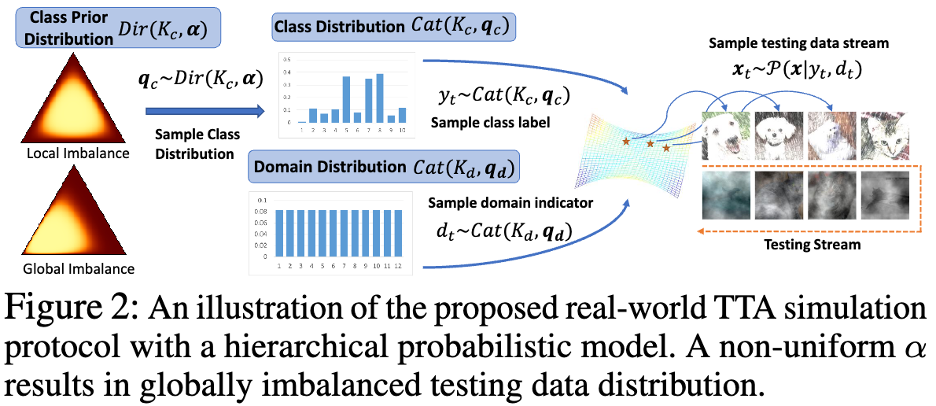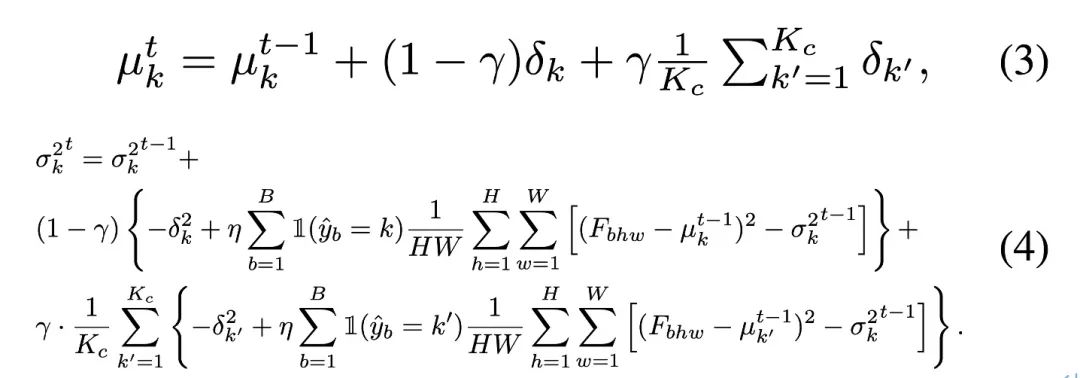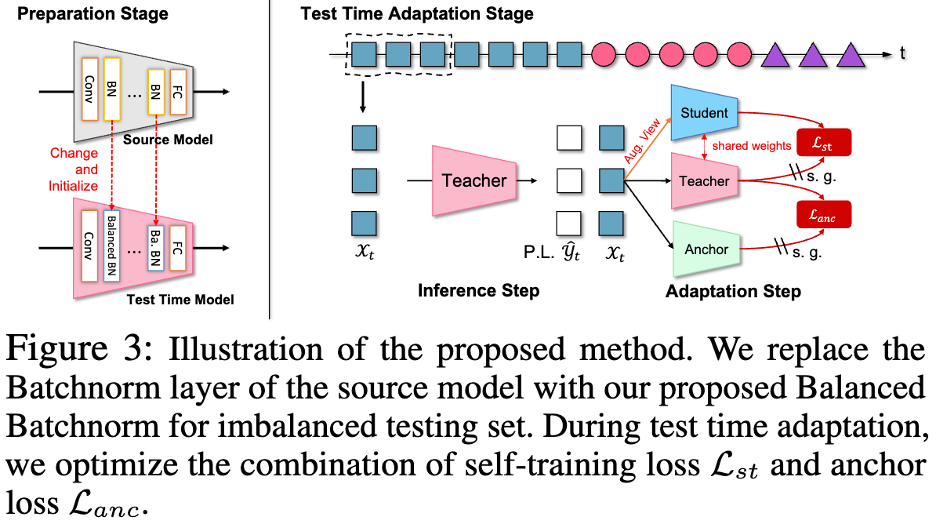 Technology peripherals
Technology peripherals
 AI
AI
 TRIBE achieves domain adaptation robustness and reaches SOTA's AAAII 2024 in multiple real-life scenarios.
TRIBE achieves domain adaptation robustness and reaches SOTA's AAAII 2024 in multiple real-life scenarios.
TRIBE achieves domain adaptation robustness and reaches SOTA's AAAII 2024 in multiple real-life scenarios.
The test data flow should be time-varying distribution ( Rather than a fixed distribution in traditional domain adaptation) The test data stream may have local class correlations (rather than completely independent and identically distributed sampling) The test data stream still shows global category imbalance for a long time

The success of deep neural networks relies on generalizing the trained model to i.i.d. assumptions in the test domain . However, in practical applications, the robustness of out-of-distribution test data, such as visual damage caused by different lighting conditions or severe weather, is a concern. Recent research shows that this data loss can seriously affect the performance of pre-trained models. Importantly, the corruption (distribution) of test data is often unknown and sometimes unpredictable before deployment.
Therefore, adjusting the pre-trained model to adapt to the test data distribution in the inference phase is a worthy new topic, namely test-time domain adaptation (TTA). Previously, TTA was mainly implemented through distribution alignment (TTAC, TTT), self-supervised training (AdaContrast) and self-training (Conjugate PL), which have brought significant and robust improvements in a variety of visual damage test data.
Existing test-time domain adaptation (TTA) methods are usually based on some strict test data assumptions, such as stable class distribution, samples obey independent and identically distributed sampling, and fixed domain offset. These assumptions have inspired many researchers to explore real-world test data flows, such as CoTTA, NOTE, SAR, and RoTTA.
Recently, research on real-world TTA, such as SAR (ICLR 2023) and RoTTA (CVPR 2023), has mainly focused on the challenges posed by local class imbalance and continuous domain shift to TTA. Local class imbalance usually results from the fact that the test data is not sampled independently and identically distributedly. Direct indiscriminate domain adaptation will lead to biased distribution estimates.
Recent research has proposed exponentially updated batch normalized statistics (RoTTA) or instance-level discriminative updated batch normalized statistics (NOTE) to solve this challenge. The research goal is to transcend the challenge of local class imbalance, considering that the overall distribution of test data may be severely imbalanced and the distribution of classes may also change over time. A diagram of a more challenging scenario can be seen in Figure 1 below.

Domain shifts occur frequently in real-world test data over time, such as gradual changes in lighting/weather conditions. This brings another challenge to existing TTA methods, the TTA model may become inconsistent when switching from domain A to domain B due to over-adaptation to domain A.
In order to alleviate over-adaptation to a certain short-term domain, CoTTA randomly restores parameters, and EATA uses fisher information to regularize the parameters. Nonetheless, these methods still do not explicitly address the emerging challenges in the field of test data.
This article introduces an anchor network (Anchor Network) to form a three-network self-training model (Tri-Net Self-Training) based on the two-branch self-training architecture. The anchor network is a frozen source model but allows tuning statistics rather than parameters in the batch normalization layer via test samples. And an anchoring loss is proposed to use the output of the anchor network to regularize the output of the teacher model to avoid the network from over-adapting to the local distribution.
The final model combines a three-net self-training model and a balanced batch normalization layer (TRI-net self-training with BalancEd normalization, TRIBE) to perform well in a wider range of adjustable learning rates. Consistently superior performance. It shows substantial performance improvements under four data sets and multiple real-world data streams, demonstrating the unique stability and robustness.
- Introducing the TTA protocol in the real world;
- Balanced batch normalization;
- Three-network self-training model.


The following figure shows the frame diagram of the TRIBE network: 

 or the pseudo-label accuracy is low (accuracy
or the pseudo-label accuracy is low (accuracy




The above is the detailed content of TRIBE achieves domain adaptation robustness and reaches SOTA's AAAII 2024 in multiple real-life scenarios.. For more information, please follow other related articles on the PHP Chinese website!

Hot AI Tools

Undresser.AI Undress
AI-powered app for creating realistic nude photos

AI Clothes Remover
Online AI tool for removing clothes from photos.

Undress AI Tool
Undress images for free

Clothoff.io
AI clothes remover

AI Hentai Generator
Generate AI Hentai for free.

Hot Article

Hot Tools

Notepad++7.3.1
Easy-to-use and free code editor

SublimeText3 Chinese version
Chinese version, very easy to use

Zend Studio 13.0.1
Powerful PHP integrated development environment

Dreamweaver CS6
Visual web development tools

SublimeText3 Mac version
God-level code editing software (SublimeText3)

Hot Topics
 1379
1379
 52
52
 The author of ControlNet has another hit! The whole process of generating a painting from a picture, earning 1.4k stars in two days
Jul 17, 2024 am 01:56 AM
The author of ControlNet has another hit! The whole process of generating a painting from a picture, earning 1.4k stars in two days
Jul 17, 2024 am 01:56 AM
It is also a Tusheng video, but PaintsUndo has taken a different route. ControlNet author LvminZhang started to live again! This time I aim at the field of painting. The new project PaintsUndo has received 1.4kstar (still rising crazily) not long after it was launched. Project address: https://github.com/lllyasviel/Paints-UNDO Through this project, the user inputs a static image, and PaintsUndo can automatically help you generate a video of the entire painting process, from line draft to finished product. follow. During the drawing process, the line changes are amazing. The final video result is very similar to the original image: Let’s take a look at a complete drawing.
 Topping the list of open source AI software engineers, UIUC's agent-less solution easily solves SWE-bench real programming problems
Jul 17, 2024 pm 10:02 PM
Topping the list of open source AI software engineers, UIUC's agent-less solution easily solves SWE-bench real programming problems
Jul 17, 2024 pm 10:02 PM
The AIxiv column is a column where this site publishes academic and technical content. In the past few years, the AIxiv column of this site has received more than 2,000 reports, covering top laboratories from major universities and companies around the world, effectively promoting academic exchanges and dissemination. If you have excellent work that you want to share, please feel free to contribute or contact us for reporting. Submission email: liyazhou@jiqizhixin.com; zhaoyunfeng@jiqizhixin.com The authors of this paper are all from the team of teacher Zhang Lingming at the University of Illinois at Urbana-Champaign (UIUC), including: Steven Code repair; Deng Yinlin, fourth-year doctoral student, researcher
 Posthumous work of the OpenAI Super Alignment Team: Two large models play a game, and the output becomes more understandable
Jul 19, 2024 am 01:29 AM
Posthumous work of the OpenAI Super Alignment Team: Two large models play a game, and the output becomes more understandable
Jul 19, 2024 am 01:29 AM
If the answer given by the AI model is incomprehensible at all, would you dare to use it? As machine learning systems are used in more important areas, it becomes increasingly important to demonstrate why we can trust their output, and when not to trust them. One possible way to gain trust in the output of a complex system is to require the system to produce an interpretation of its output that is readable to a human or another trusted system, that is, fully understandable to the point that any possible errors can be found. For example, to build trust in the judicial system, we require courts to provide clear and readable written opinions that explain and support their decisions. For large language models, we can also adopt a similar approach. However, when taking this approach, ensure that the language model generates
 From RLHF to DPO to TDPO, large model alignment algorithms are already 'token-level'
Jun 24, 2024 pm 03:04 PM
From RLHF to DPO to TDPO, large model alignment algorithms are already 'token-level'
Jun 24, 2024 pm 03:04 PM
The AIxiv column is a column where this site publishes academic and technical content. In the past few years, the AIxiv column of this site has received more than 2,000 reports, covering top laboratories from major universities and companies around the world, effectively promoting academic exchanges and dissemination. If you have excellent work that you want to share, please feel free to contribute or contact us for reporting. Submission email: liyazhou@jiqizhixin.com; zhaoyunfeng@jiqizhixin.com In the development process of artificial intelligence, the control and guidance of large language models (LLM) has always been one of the core challenges, aiming to ensure that these models are both powerful and safe serve human society. Early efforts focused on reinforcement learning methods through human feedback (RL
 arXiv papers can be posted as 'barrage', Stanford alphaXiv discussion platform is online, LeCun likes it
Aug 01, 2024 pm 05:18 PM
arXiv papers can be posted as 'barrage', Stanford alphaXiv discussion platform is online, LeCun likes it
Aug 01, 2024 pm 05:18 PM
cheers! What is it like when a paper discussion is down to words? Recently, students at Stanford University created alphaXiv, an open discussion forum for arXiv papers that allows questions and comments to be posted directly on any arXiv paper. Website link: https://alphaxiv.org/ In fact, there is no need to visit this website specifically. Just change arXiv in any URL to alphaXiv to directly open the corresponding paper on the alphaXiv forum: you can accurately locate the paragraphs in the paper, Sentence: In the discussion area on the right, users can post questions to ask the author about the ideas and details of the paper. For example, they can also comment on the content of the paper, such as: "Given to
 Axiomatic training allows LLM to learn causal reasoning: the 67 million parameter model is comparable to the trillion parameter level GPT-4
Jul 17, 2024 am 10:14 AM
Axiomatic training allows LLM to learn causal reasoning: the 67 million parameter model is comparable to the trillion parameter level GPT-4
Jul 17, 2024 am 10:14 AM
Show the causal chain to LLM and it learns the axioms. AI is already helping mathematicians and scientists conduct research. For example, the famous mathematician Terence Tao has repeatedly shared his research and exploration experience with the help of AI tools such as GPT. For AI to compete in these fields, strong and reliable causal reasoning capabilities are essential. The research to be introduced in this article found that a Transformer model trained on the demonstration of the causal transitivity axiom on small graphs can generalize to the transitive axiom on large graphs. In other words, if the Transformer learns to perform simple causal reasoning, it may be used for more complex causal reasoning. The axiomatic training framework proposed by the team is a new paradigm for learning causal reasoning based on passive data, with only demonstrations
 A significant breakthrough in the Riemann Hypothesis! Tao Zhexuan strongly recommends new papers from MIT and Oxford, and the 37-year-old Fields Medal winner participated
Aug 05, 2024 pm 03:32 PM
A significant breakthrough in the Riemann Hypothesis! Tao Zhexuan strongly recommends new papers from MIT and Oxford, and the 37-year-old Fields Medal winner participated
Aug 05, 2024 pm 03:32 PM
Recently, the Riemann Hypothesis, known as one of the seven major problems of the millennium, has achieved a new breakthrough. The Riemann Hypothesis is a very important unsolved problem in mathematics, related to the precise properties of the distribution of prime numbers (primes are those numbers that are only divisible by 1 and themselves, and they play a fundamental role in number theory). In today's mathematical literature, there are more than a thousand mathematical propositions based on the establishment of the Riemann Hypothesis (or its generalized form). In other words, once the Riemann Hypothesis and its generalized form are proven, these more than a thousand propositions will be established as theorems, which will have a profound impact on the field of mathematics; and if the Riemann Hypothesis is proven wrong, then among these propositions part of it will also lose its effectiveness. New breakthrough comes from MIT mathematics professor Larry Guth and Oxford University
 The first Mamba-based MLLM is here! Model weights, training code, etc. have all been open source
Jul 17, 2024 am 02:46 AM
The first Mamba-based MLLM is here! Model weights, training code, etc. have all been open source
Jul 17, 2024 am 02:46 AM
The AIxiv column is a column where this site publishes academic and technical content. In the past few years, the AIxiv column of this site has received more than 2,000 reports, covering top laboratories from major universities and companies around the world, effectively promoting academic exchanges and dissemination. If you have excellent work that you want to share, please feel free to contribute or contact us for reporting. Submission email: liyazhou@jiqizhixin.com; zhaoyunfeng@jiqizhixin.com. Introduction In recent years, the application of multimodal large language models (MLLM) in various fields has achieved remarkable success. However, as the basic model for many downstream tasks, current MLLM consists of the well-known Transformer network, which



